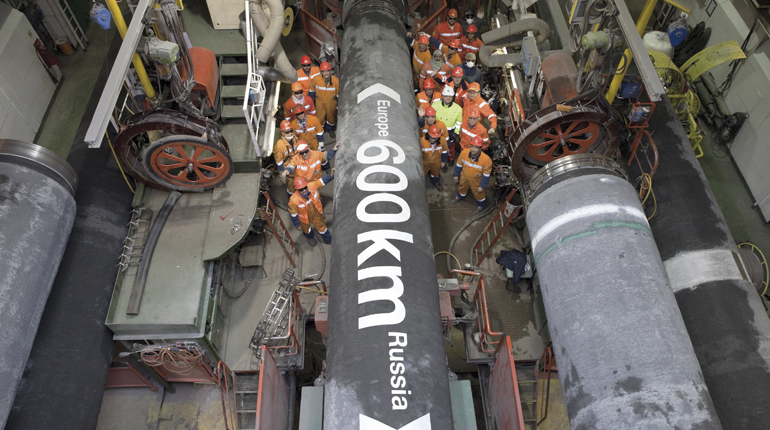Mozambique close to agreeing Coral FLNG plan
State regulator INP is close to agreeing a plan of development for Coral FLNG, while the unitisation agreement with Anadarko could lead to a more ambitious onshore plan.
 Anadarko drilling off Mozambique’s coast. (Anadarko)
Anadarko drilling off Mozambique’s coast. (Anadarko)
Mozambique’s state petroleum regulator, the INP, is close to agreeing a plan of development for the 2.5 mtpa Coral FLNG project with Eni and its partners in Offshore Area 4.
Interfax understands a plan could be settled as early as this week, although it would still need final approval from the Council of Ministers, which would only come in the new year.
The project will be developed under a tolling model, but the INP has made adjustments to the original structure proposed by Eni and its partners.
The Area 4 partners are negotiating with lead bidders Samsung Heavy Industries, Technip and JGC to conclude the EPCIC contract.
Eni is finalising the terms of the sales and purchase agreement with BP and negotiations should be concluded in a few weeks. The contract is oil-linked with a slope in the region of 11-11.5%, sources in London told Interfax.
The 2.5 mtpa facility, which will be based on reserves from the Coral field in the Rovuma Basin, is estimated to cost $5-7 billion. It was presented to more than 30 project finance banks in London in October, but the bulk of the debt will be provided by export credit agencies from South Korea, China and Italy. The Area 4 shareholders will carry state oil company ENH’s 10% share in the project.
Eni is still looking to dilute its 50% stake in Area 4 to help finance its share of the project. Chinese state utility Huadian was among the bidders reported to be negotiating for around a 15% stake in the block.
The state power producer is looking to secure new LNG supplies in anticipation of a potential boom in domestic demand in China five years from now, but it is unusual for the company to look to take a position in the upstream.
Onshore optimisation
The Italian major’s 10 mtpa onshore LNG facility is moving slower than the offshore development. FEED work finished a few months ago and selection of the EPC contractor, expected in early 2016, is likely to be pushed back.
Interfax understands it is possible the contractors will be asked to resubmit an ‘optimised’ proposal. This would be adjusted to reflect the new costs of construction in today’s low oil price environment. It would also take advantage of the increased gas reserves Area 4 shareholders have access to now a unitisation agreement has been concluded with Anadarko for the giant fields straddling the two areas.
Under the terms of the agreement, the Prosperidade and Mamba straddling gas reservoirs will be developed in a separate but coordinated manner until a total of 680 billion cubic metres of gas has been extracted – 340 bcm from each area.
All subsequent development of the reservoirs, which hold in excess of 4.25 trillion cubic metres of gas, will be pursued jointly by the Area 1 and 4 concessionaires through a 50/50 joint-venture operator.
New ‘optimised’ EPC bids for the onshore include increasing the capacity of each train to 6 mtpa – as Anadarko has done – or even opting to build four trains rather than two, which could potentially offer savings of up to 30%, Interfax understands.
But while increasing the contract value would give more bargaining power in negotiations with suppliers and subcontractors – and the ‘design one, build many’ model would drive efficiencies and cost savings on a per ton basis – the absolute value of the project would be much higher.
Finding the financing and LNG offtake contracts for a 20-mtpa project would be a major challenge in today’s market, one contractor told Interfax.
Changes to the project design are not certain, "[but] now there is a unitisation and operating agreement in place, maybe the two companies could sit down together and look at it with a different perspective", a Maputo-based source told Interfax.
This would be a boon for the government. Aside from the increased export revenues, the more trains Mozambique brings online the more domestic gas will be brought onshore to support industrialisation. There are several projects the government is keen to develop, including a fertiliser plant by Norwegian fertiliser giant Yara and a GTL plant proposed by Shell.
However, the memorandum of understanding Anadarko signed with the government last week commits it to only 2.83 million cubic metres per day (MMcm/d) for the domestic market under the first phase of the LNG development. This will be enough to develop a small power plant or fertiliser facility, but a 30,000 barrel per day GTL train needs almost 8.50 MMcm/d of gas.
Anadarko has agreed to commit an additional 8.50 MMcm/d as it brings more trains online, but it is uncertain when this will be.
Liked this article?
Sign up for exclusive, accurate and up-to-date natural gas news, analysis and intelligence, with global coverage of every phase of the gas chain.
By logging in or signing up for a free trial, you are agreeing to our terms and conditions, privacy policy and cookie policy.







